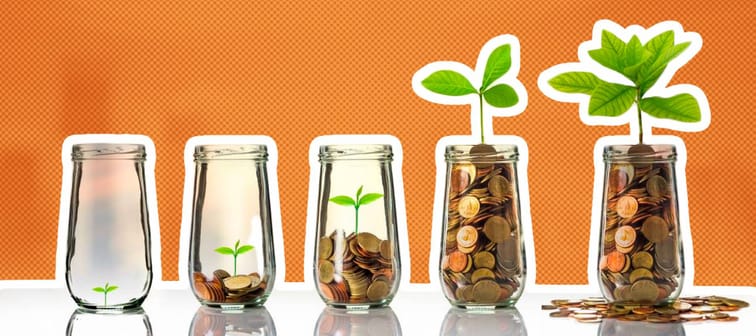How do high-yield savings accounts work?
With a high-yield savings account, you’ll earn a lot more interest than you would with a traditional savings account or checking account.
As a result, you’ll generate more money from your savings over a shorter amount of time.
The average regular savings account in the U.S. has an average interest rate of 0.45%, according to data from the FDIC. A traditional checking account has an average interest rate of just 0.07%.
In comparison, a high-yield savings account could come with a 4% interest rate.
If you were to put $1,000 into a traditional savings account with a 0.45% interest rate, you’d only earn $4.50 in interest during an entire year.
Now, let’s say you put that $1,000 in a high-yield savings account with an interest rate of 4%. You would earn $40 in interest over the course of a year — quite a difference. And that’s without making any monthly deposits.
Requirements to open a high-yield savings account
Often with a high-yield account, you need to make a certain minimum deposit to open the account, maintain a minimum balance or pay regular fees. Every account is different, though, so be sure to compare offers carefully.
Streamline your debt repayment
Having a single loan to pay off makes it easier to manage your payments, and you can often get a better interest rate than what you might be paying on credit cards and car loans.
Fiona is an online marketplace offering personalized loan options based on your unique financial situation.
When you consolidate your debt with a personal loan through Fiona, you can roll your payments into one monthly installment. Find a lower interest rate and pay down your debt faster with Fiona today.
Find your rateWhy open a high-yield savings account?
While stashing your money in a regular savings account isn’t a bad idea, it isn’t ideal either. The interest rate on a traditional savings account could be as low as 0.01% a year — practically nothing.
On the other hand, you could invest your money in the stock market and hope to earn dividends — but you could wind up losing a bundle if the investment doesn’t pan out. On top of that, the money you invest can’t be easily turned into a liquid asset if you need it right away.
A high-yield savings account is a middle ground. High-yield savings accounts pay substantially more than traditional savings accounts, giving the funds you deposit the chance to grow.
More: Savings goal calculator
High-yield savings accounts are secure
Similar to traditional savings accounts, high-yield accounts are federally insured up to $250,000 if you're dealing with a bank insured by the Federal Deposit Insurance Corporation (FDIC), or a credit union insured by the National Credit Union Administration (NCUA).
Old-school brick-and-mortar financial institutions aren’t your only secure option though; a growing number of high-yield savings accounts are being offered by online banks, and the FDIC insures many of them as well.
How to choose a high-yield savings account
Before you open a high-yield savings account it’s worthwhile to shop around a bit. You can start with the institution where your current checking or savings account is held, but check online banking offers as well.
There are a few key things you should look for when comparing options for a high-yield account.
Interest rate
You’ll likely be drawn to the high-yield accounts that offer the highest interest rates, but you should clarify whether the rate being offered is standard or if it’s an introductory rate that will change after a certain amount of time.
Some banks will offer an attractive rate to start, but if it decreases after a set period of time you could wind up making less money than you would if you’d gone with a slightly-lower standard rate.
You should also look into whether there are minimum or maximum thresholds you need to meet in order to maintain that interest rate, and confirm that they’re feasible for you.
Minimum deposit/balance
Many financial institutions will require you to make an initial deposit to open a high-yield account with them, so you should make sure that you’re comfortable setting aside that amount of money upfront.
There may also be minimum balance requirements in order to keep your account active; falling below the minimum balance could result in fees or affect your interest rate.
APY
When you start looking for a high-yield account, the first number you’ll see will be APY, or annual percentage yield.
APY is the yearly rate of return on the money in your account, and it includes compound interest, which is the interest earned on your interest.
The more often your investment compounds and builds interest on the interest already earned, the faster your savings grow.
It’s a good idea to get into the habit of making regular contributions every month, since that will increase the amount of money in your account earning interest.
Fees
Some financial institutions may charge introductory fees for opening a high-yield account, and monthly maintenance fees for keeping it open. It’s important that you understand what these fees are and whether there are ways to avoid them.
You should also check whether there’s a fee for exceeding a certain amount of withdrawals from your savings account per month.
Access to your money
How easy it will be to access the money in your high-yield account is another thing to consider. Some banks will allow you to make withdrawals instantly using an ATM card, while others may require a waiting period of several days before your transaction is processed.
As mentioned above, easy access to your savings might not always be a good thing; if you can dip into your account anytime you want, it may take you longer to reach your savings goal than you’d like. Know your level of self-restraint and plan accordingly.
Ways to deposit money
You’ll also want to look into the options available for depositing money in your account. Some financial institutions offer convenient mobile apps, while others may require deposits to be in the form of a check.
If the high-yield account you’re considering is not with your primary bank, make sure that the option for bank-to-bank transfers is available.
More: Best high-yield savings accounts
Stop overpaying for home insurance
Home insurance is an essential expense – one that can often be pricey. You can lower your monthly recurring expenses by finding a more economical alternative for home insurance.
SmartFinancial can help you do just that. SmartFinancial’s online marketplace of vetted home insurance providers allows you to quickly shop around for rates from the country’s top insurance companies, and ensure you’re paying the lowest price possible for your home insurance.
Explore better rates5 reasons to open a high-yield savings account
The great thing about a high-yield savings account is that it’s versatile.
Whether you’re planning for your wedding or preparing for retirement, you can rest easy knowing that the money you’re putting toward your goal is growing.
1. Emergency savings. You never know when you’ll need money for unexpected expenses, and a high-yield savings account is a great place to store your emergency fund.
At minimum, you should have enough emergency money saved to cover your expenses for three months, and that extra interest may come in handy if you need cash in a hurry.
2. Vacation fund. If you’re hoping to take a big vacation in the next few years, keeping your travel budget in a high-yield account is a smart idea. Depending on how far ahead you start saving, the interest you earn may be enough to cover the cost of your plane ticket — or at the very least sample some of the local cuisine.
3. Major purchase. High-yield savings accounts are also ideal if you’re saving up for a major purchase, like a new car or a home renovation. Instead of just sitting in your bank account, your funds can continue growing at a more rapid pace.
4. General savings. You can open a high-yield account even if you don’t have a specific plan in mind for the money. If you have surplus cash sitting around in your checking account, there’s no downside to putting it into a high-yield savings account and letting it earn you money.
5. Mulitple savings goals. Opening multiple high-yield accounts can be helpful if you’re saving for a variety of different things. That way if your new car costs more than expected, you won’t be tempted to dip into your emergency fund to cover the difference.
Having more than one account will also allow you to take advantage of multiple perks, like higher introductory rates or new account bonuses.
More: Money market accounts vs. savings accounts: Which earns more?
Sponsored
Follow These Steps if you Want to Retire Early
Secure your financial future with a tailored plan to maximize investments, navigate taxes, and retire comfortably.
Zoe Financial is an online platform that can match you with a network of vetted fiduciary advisors who are evaluated based on their credentials, education, experience, and pricing. The best part? - there is no fee to find an advisor.








